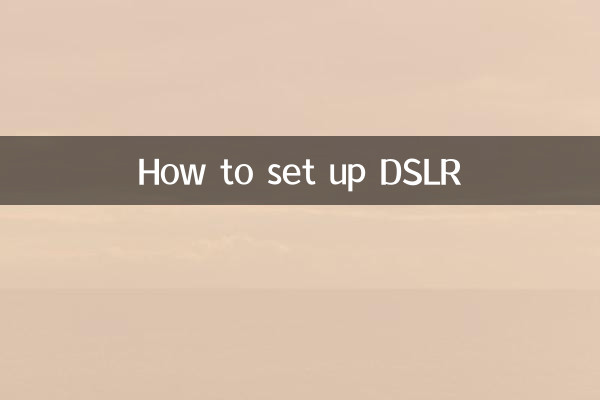How to set up a DSLR: a comprehensive guide from beginner to proficient
DSLR cameras are the preferred equipment for photography enthusiasts and professional photographers, but how to set up a DSLR camera correctly is a problem faced by many beginners. This article will combine the hot topics and hot content on the Internet in the past 10 days to provide you with a detailed analysis of the setting methods of SLR cameras to help you quickly master shooting skills.
1. Basic settings of SLR camera

The basic settings of an SLR camera include shooting mode, aperture, shutter speed, ISO and other parameters. Here are common setup recommendations:
| parameter | Recommended value | Applicable scenarios |
|---|---|---|
| shooting mode | Aperture priority (A/Av) | portrait, landscape |
| aperture | f/2.8-f/5.6 | Bokeh |
| shutter speed | 1/125s or more | moving object |
| ISO | 100-400 | Sufficient light |
2. Advanced setting skills
In addition to basic settings, DSLR cameras have many advanced features that can help you improve your shooting results. Here are some of the most popular advanced setup tips these days:
1.White balance settings: Adjust white balance according to light conditions to avoid color cast in photos. For example, using Cloudy mode in overcast conditions can enhance the warmth of your photos.
2.focus mode: SLR cameras usually provide multiple focus modes, such as single focus (AF-S), continuous focus (AF-C), etc. When shooting moving objects, it is recommended to use continuous focus mode.
3.exposure compensation: In backlit or high-contrast scenes, you can avoid overexposure or underexposure of photos by adjusting exposure compensation.
| Advanced features | Setting suggestions | Effect |
|---|---|---|
| white balance | Choose according to environment | color reproduction |
| focus mode | AF-C | Track moving objects |
| exposure compensation | +1/-1EV | Adjust light and dark |
3. Recommended settings for popular scenes
Based on recent hot topics, the following are recommended SLR settings for several common shooting scenarios:
1.Night scene shooting: Use a tripod to fix the camera, set a low ISO (such as 100), a small aperture (such as f/8) and a slow shutter speed (such as 5 seconds) to get clear night scene photos.
2.portrait shooting: Select a large aperture (such as f/1.8) to blur the background, and use single focus mode to focus on the person's eyes to ensure the subject is clear.
3.sports photography: Set high-speed shutter (such as 1/500s) and continuous focus mode to capture fast-moving objects.
| scene | aperture | shutter speed | ISO |
|---|---|---|---|
| night view | f/8 | 5s | 100 |
| portrait | f/1.8 | 1/125s | 200 |
| sports | f/5.6 | 1/500s | 400 |
4. Frequently Asked Questions
1.Why are photos blurry?It may be that the shutter speed is too slow or the focus is inaccurate. It is recommended to increase the shutter speed or check the focus mode.
2.How to avoid noise?Try to use a low ISO and reduce noise in post-processing.
3.How to take photos with background blur effect?Use a wide aperture (such as f/1.8) and keep your subject away from the background.
Conclusion
The settings of an SLR camera need to be flexibly adjusted according to specific scenes and shooting needs. By mastering the above tips, you will be able to better utilize the potential of your DSLR camera and take high-quality photos. If you have more questions, please leave a message in the comment area to discuss!

check the details

check the details